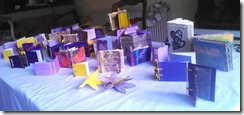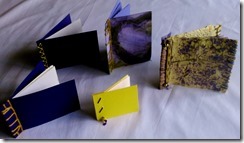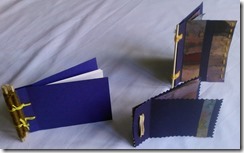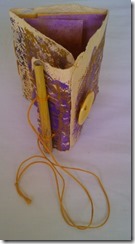This chapter is in preparation for the final project for this module, we have to make a finished item developed from ideas we have developed so far, in the form of a book or port-folio-type structure.
We have to think imaginatively as books can come in all shapes and forms but we need to consider some mock-ups of our ideas and how our embroidery techniques could be incorporated upon at least one embroidered panel within the structure.
I haven’t used my best hand made papers as I need to keep them for later but I found some yellow and purple card and papers to practice with. Although these were great for getting to grips with the techniques I decided I wanted to use some more interesting papers for effect. Along with less precious hand made papers I found some old ones I’d used for transfer printing which were great – never throw anything away!
I’ve included both sets here so it may look as if I’ve repeated myself but I had loads of fun working through this chapter. This is new to me and I’ve always wanted to learn how to make books so I seized the opportunity full on!
1. Pamphlet books. These are simple books made by folding pages and inserting them into a firmer outer cover. Each set of pages is known as a pamphlet and is held in pace by stitching. These are hand stitched using 3 or 5 holes depending on the size of the book. Accurate folds are made with the aid of a bone folder and the holes for stitching accurately measured and pierced to ensure that the cover and pages are in alignment.
2. Multiple books have been made from a longer outer cover to accommodate more sets of pamphlets in the folds. It was interesting to play around with different textures of paper.
3. Here the outer cover and pamphlets are in the shape of a leaf and have been secured by machine stitching.
4. Extra folds in the spine allow for insertion of extra pamphlets
5. The addition of an external spine with cover and pamphlets secured by thread or ribbon
6. Decorative stitching has been used to secure the pages. Again accurate folds and placing of the holes for stitching are necessary. A fold adjacent to the stitching allows for the book to be opened easily. I was interested in the edgings we looked at in a previous chapter so experimented more with this on the right hand sample.
7. These books have been made out of 2 flat covers inside which the pamphlets have been secured with a decorative chain stitch which weaves horizontally across the spine. I love this technique and spent extra time on it to make some books from some precious collaged boards I’d already made. I use some machine wrapped threads to add colour and texture
8. Pamphlets secured by stitching into the spine
9. Pamphlets turned into books in the absence of a cover by using strips of paper glued in place and stitched in place as before and incorporating the strips of paper
10. Variations on a theme – One book with stitching into the spine [left] , exposed spine and pamphlets stitched and woven together [centre]. I made the one on the right at Summer School about 4 years ago, the pamphlets are stitched individually and then needle woven together. In all three ends of thread are left on the outside and beads added.
11. Multiple book with cover and pages joined with blanket stitch as separate entities and then brought together with insertion stitch. Love this!
12. Unusual bindings . Left to right: needle woven sticks, rubber band with it’s ends held in place by stiff card at the back and single stick all used with an exposed spine.
13. Pamphlet stitch used to incorporate sticks at their centre with a cork base and button fastening on the left and same book opened up on the right
14. Concertina book. Long piece of paper folded in concertina fashion and two ends glued to cover. It folds in nicely or stretched out as shown.
15. Clever folding and cutting. An A4 sheet has been folded in half lengthwise and then across the length three times before being cut along the centre as shown.
16. Pages threaded together with beads to separate them and hung horizontally
17. Wrap around book and experiments with closures
17. The complete set!


























Beautiful colours and lovely books Carrie! I especially like your last picture of your whole library of gorgeous books. It is obvious that you have loved this chapter as much as I have.
ReplyDeleteI certainly did Catherine, such a wonderful skill to have!
ReplyDeleteNot quite sure why my son's name is coming up here!!
ReplyDelete